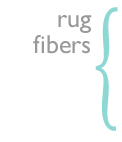LEARN // RUG FIBERS
Although area rugs are often purchased primarily for their “look,” they also must perform well. Performance, in large part, is dictated by what the actual rug is made of. We invite you to explore below and learn about the benefits of various fibers such as wool, silks and synthetics.
| Rug FIbers | |||
 |
The principal characteristics of rug fibers are: 1) Density - Refers to the closeness or tightness of the tufts or knots. The more dense the pile, the better the life and wear resistance. 2) Twist - This term describes the winding or spinning of yarn fibers around themselves. A tight yarn twist is desired for optimum resilience. There are two basic categories of rug fibers (natural and synthetic) and each material within the category has distinct characteristics. The type of fiber chosen for use in your rug will also help to determine its appearance and performance. Most fibers provide brilliant colors, easy maintenance, softness and outstanding value. |
||
| Natural | |||
 |
|
||
| Synthetic | |||
 |
Acrylic- Acrylics have the appearance of wool and are often used for bathroom and “fun” rugs. Wear properties are fair and costs are favorable. However, acrylics are often blended with other man-made fibers.
Nylon - Resists soiling, wears well and is easily cleaned. Available in a wide variety of brilliant colors. Nylon is known for its resilience and performs well under heavy traffic and will also withstand movement of heavy furniture. Moderate cost level. Olefins - Polypropylene is strong and has a wool-like feel. It resists wear and stains. It is colorfast and is used primarily in machine-made rugs. Both polypropylene and polyethylene are used in outdoor carpet applications. Moderate cost level. Polyester - Has many of the features of the olefins. Presents a very soft “hand” when used in thick, cut-pile applications. Slightly more expensive than olefins. Blends - Any of the above fiber types may be combined for special performance and/or appearance properties. Other materials (gold, silver, etc.) are also sometimes incorporated. |